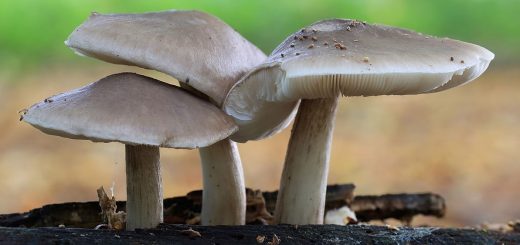#152: Amanita rubescens, The Blusher
Note: This is an archived post. Click here to read the current version of this post.
This Amanita is considered edible and many people eat it, although just as many people avoid it because it is easily confused with some deadly poisonous amanitas. Known as the “Blusher,” rubescens is notable because it stains pinkish when injured.
A. rubescens is a medium-sized to large mushroom with a classic umbrella shape. The Blusher grows 5-18cm (2-7in) tall and 4-15cm (2-6in) wide. The cap is circular, displays brownish-yellow to brown colors, develops reddish tones as the mushroom ages, and is decorated by many small warts. These warts are remnants of the universal veil (a protective membrane that surrounded the developing mushroom) and easily slough off. Members of the genus Amanita usually have both a universal and partial veil. At first, the warts are yellow but they become tan, gray, or slightly pinkish as the pileus expands.
Underneath the pileus, the mushroom displays gills that radiate from the central stipe. The gills are white, crowded, and do not touch the stipe or just barely touch the tip of the stipe. These count as “free gills,” which is one of the characteristics to look for when identifying amanitas. “Short-gills” that do not run the whole radius of the pileus are formed frequently. Like all other Amanita species, the gills drop spores that leave a white spore print.
The most prominent feature of the Blusher’s stipe is the ring. This white, skirt-like piece of tissue is all that remains of the mushroom’s partial veil, a membrane that protected the developing gills. The ring is persistent but rather flimsy and can easily be lost. The stipe is roughly equal in thickness throughout its length (1-3cm or 0.4-1in thick), though it may be enlarged at the base. Although it is initially white, the stipe discolors pinkish red, especially where damaged. The mushroom’s base does not retain any remnants of the universal veil.
One of the most important features of A. rubescens is its tendency to slowly stain pinkish red (“blush”). The mushroom’s flesh is generally white, except where damage has occurred (from insect holes or your thumb/knife, for example). When exposed to air, the surfaces slowly develop a red or pinkish color. This feature helps sort out A. rubescens from many of its look-alikes.
The Blusher is mycorrhizal (it gives nutrients to trees in exchange for sugar) with oaks and occasionally pines and other conifers. You can find it growing on the ground under these trees in the summer and fall. In warmer climates, it is also found during the winter. The mushrooms can fruit alone, in small groups, or several spread over a wide area.
A. rubescens is technically a European species. DNA studies have shown that the North American version is a different species, but it has yet to be formally described in a mycological journal. The easiest way to differentiate between the North American and European Blushers is by the continent on which they are found. However, the European A. rubescens has occasionally been exported to other continents in the soil with European trees, so it can (rarely) be found elsewhere. The American version tends to be shorter and stouter than its European counterpart and has other subtle differences that you can read about on the amanitaceae.org pages for each species (linked below).
The standard North American version is found east of the Rocky Mountains and north of Mexico. Amanita expert Rob Tulloss gives this species the provisional name Amanita amerirubescens. Based on DNA evidence only, he also identifies seven cryptic species within A. amerirubescens. No studies have correlated DNA to morphology, so for the moment it is impossible to differentiate between these species.
West of the Rocky Mountains, those mushrooms are replaced by A. novinupta (the “Western Blusher”). Compared to the eastern version, A. novinupta is completely white when young, has a slightly larger base, and has a slightly thicker stipe.
The Amanita genus is full of very similar species, many of which contain deadly toxins. Blushing helps separate out A. rubescens from many of these species, but you must check every specimen to be sure it exhibits the proper color change. A. rubescens does have a lot of variability, which makes the species easy to misidentify. One of the mushrooms most commonly mistaken for A. rubescens is the Panther Cap, A. pantherina. This deadly mushroom does not blush and has a volval sac (a remnant of the universal veil that surrounds the base) at its base, but displays similar coloration and ornamentation. Similar amanitas in the section Amidella also blush but have a volval sac and lack a ring. A. daucipes and A. roseitincta are also similar but have enlarged bases, powdery textures, and a pinkish coloration.
A. rubescens is considered edible, but it must be thoroughly cooked. When raw, the mushroom contains a hemolytic toxin that causes anemia. This is destroyed upon cooking, making the mushroom safe for human consumption. Of course, this assumes that the mushrooms have been correctly identified. Many people do not eat mushrooms from the genus Amanita because of the dire consequences of misidentification. For this reason, I recommend that you never eat an amanita. If you wish to eat the Blusher, you should first have your specimens identified by an expert. For reference, I do not trust my identification skills enough to eat Blushers that I have identified. Perhaps I will be confident enough ten or twenty years down the road.
See Further:
http://www.mushroomexpert.com/amanita_rubescens.html
http://www.amanitaceae.org/?Amanita+amerirubescens
http://www.amanitaceae.org/?Amanita+rubescens
http://www.first-nature.com/fungi/amanita-rubescens.php
http://www.rogersmushrooms.com/gallery/DisplayBlock~bid~5559.asp
http://www.mushroomthejournal.com/blushing-amanitas/
http://www.wildfooduk.com/mushroom-guides/the-blusher-mushroom/

![#143: Boletinellus merulioides, the Ash Tree Bolete [Archived]](https://www.fungusfactfriday.com/wp-content/themes/hueman/assets/front/img/thumb-medium-empty.png)






![#011: Characteristics of Kingdom Fungi [Archived]](https://www.fungusfactfriday.com/wp-content/themes/hueman/assets/front/img/thumb-small-empty.png)
